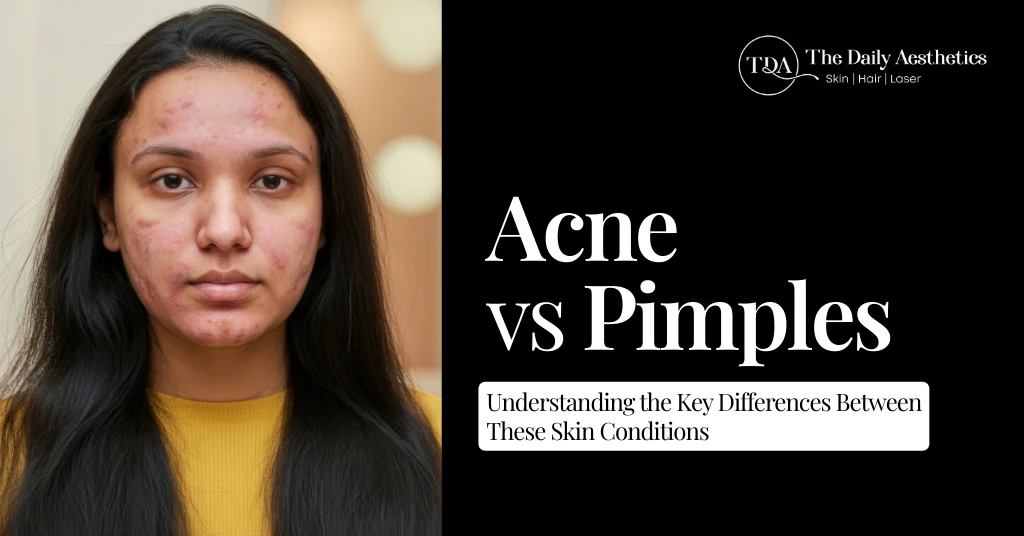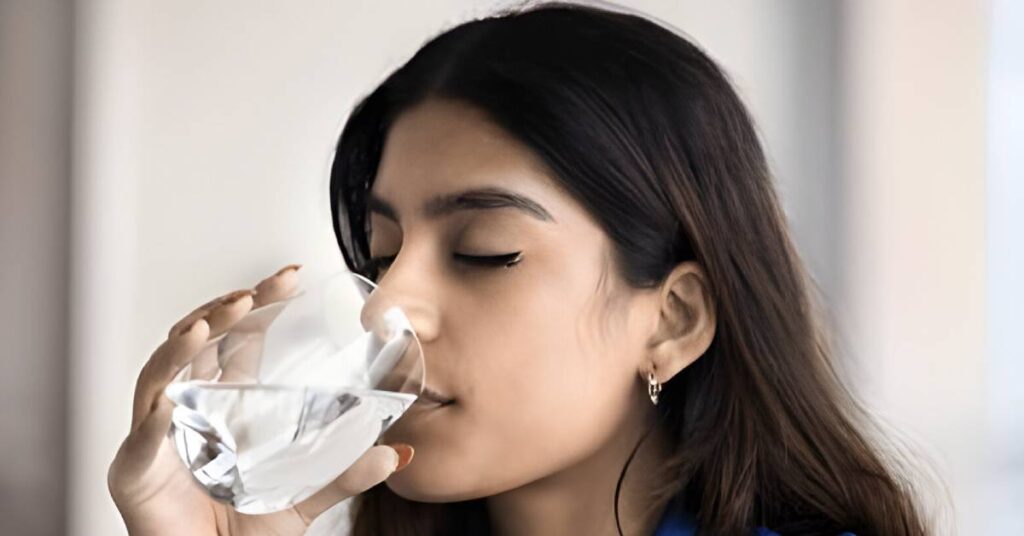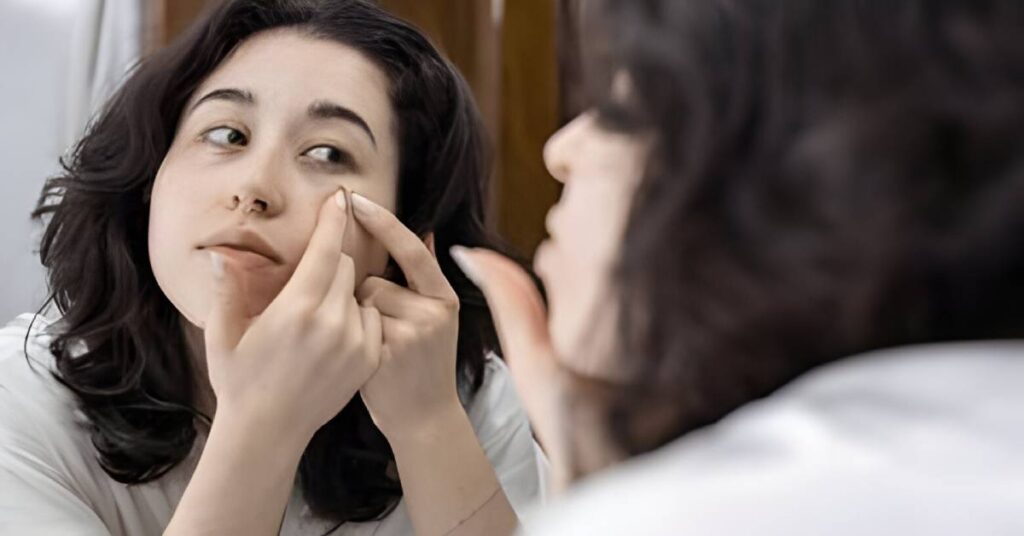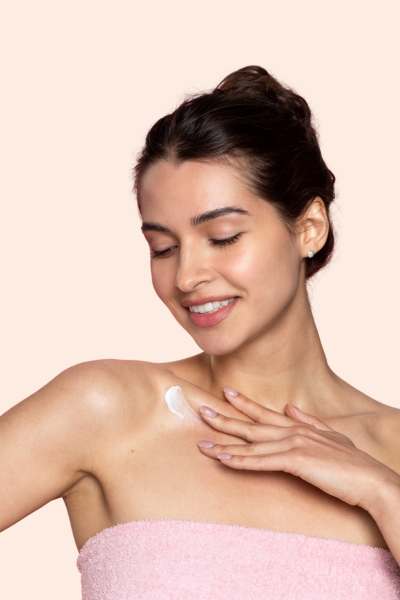You wake up, look in the mirror, and spot a red bump on your face.
Your first thought?
“Great, another pimple.”
But then you start wondering – is this actually a pimple, or is it acne?
And wait, aren’t they the same thing anyway?
If you’ve ever found yourself confused about the difference between acne and pimples, you’re definitely not alone.
Most people use these terms interchangeably, but here’s the thing – they’re actually not the same. Understanding this distinction isn’t just about getting your skincare vocabulary right; it can completely change how you approach treating your skin concerns.
When you know whether you’re dealing with an occasional pimple or a more complex acne condition, you can choose the right treatments, set realistic expectations, and avoid wasting money on products that won’t work for your specific situation.
You’ll also know when it’s time to put down the drugstore creams and schedule an appointment with a dermatologist.
In this comprehensive guide, you’ll discover exactly what sets acne apart from pimples, learn about the different causes behind each condition, and explore the most effective treatment options available.
What is Acne?
Acne is a chronic skin condition that affects your hair follicles and oil glands.
When you have acne, your pores become clogged with oil, dead skin cells, and bacteria, creating an environment where different types of breakouts can develop.
Here’s what makes acne different from isolated skin bumps: it’s persistent and recurring. You might clear up one area only to have new breakouts appear in the same spots or nearby areas.
This happens because the underlying issues causing your acne, like overactive oil glands or hormonal fluctuations, are still present even after individual blemishes heal.
Acne shows up in various forms on your skin.
You might notice blackheads (those dark spots in your pores), whiteheads (small white or flesh-colored bumps), papules (red, inflamed bumps), pustules (pus-filled bumps), nodules (large, deep, painful lumps), or cysts (deep, pus-filled lumps that can cause scarring).
The presence of multiple types of these lesions, especially when they keep coming back in the same areas, is a clear sign you’re dealing with acne rather than occasional pimples.
What are Pimples?
A pimple is simply an individual skin lesion – that single red, inflamed bump that seems to appear out of nowhere.
Unlike acne, which is an ongoing condition, a pimple is more like a one-time event. You get a clogged pore, it becomes inflamed, and eventually, it heals and disappears.
When you develop a pimple, here’s what’s happening: a single pore gets blocked by a combination of oil, dead skin cells, and sometimes bacteria.
Your body’s immune system responds to this blockage by sending white blood cells to the area, which causes the redness, swelling, and sometimes pus that you see. Once your immune system does its job and the blockage clears, the pimple goes away.
The key thing about pimples is that they’re usually isolated incidents. You might get one before your period, after eating certain foods, or when you’re stressed.
But they don’t necessarily indicate an underlying skin condition. Many people get occasional pimples throughout their lives without ever developing acne.
Acne vs Pimples: Key Differences
Now that you understand what each condition involves, let’s break down the key differences in an easy-to-compare format.
This table will help you quickly identify whether you’re dealing with acne or just occasional pimples.
| Aspect | Acne | Pimples |
| Nature | Chronic skin condition | Individual skin lesions |
| Duration | Persistent and recurring over months/years | Temporary, lasting 1-2 weeks per occurrence |
| Frequency | Multiple lesions present at once, continuous breakouts | Occasional, isolated bumps |
| Types | Multiple types: blackheads, whiteheads, papules, pustules, nodules, cysts | Usually just inflamed red bumps, sometimes with pus |
| Location | Face, chest, back, shoulders, upper arms | Most commonly face, occasionally body |
| Severity | Can range from mild to severe with scarring | Generally mild to moderate |
| Age of Onset | Often begins during puberty, can persist into adulthood | Can occur at any age |
| Treatment | Requires ongoing management and specialized treatments | Often resolves with basic skincare or spot treatments |
| Underlying Cause | Hormonal imbalances, genetics, overactive oil glands | Temporary pore blockage, stress, diet, or hormonal fluctuations |
| Pattern | Affects the same areas repeatedly | Random occurrence |
| Professional Care | Often requires dermatologist consultation | Usually manageable with over-the-counter products |
Looking at this comparison, you can see why it’s important to distinguish between the two.
If you’re experiencing multiple types of lesions that keep coming back in the same areas, you’re likely dealing with acne and should consider more comprehensive treatment approaches.
Acne and Pimples Causes & Risk Factors
While acne and pimples share some common triggers, there are important differences in what makes each condition more likely to develop.
Both acne and pimples start with the same basic process: your pores get clogged. This happens when your skin produces too much oil (sebum), dead skin cells build up, or bacteria multiply in your pores.
However, the underlying reasons why this occurs can vary significantly between the two conditions.
- Hormonal Influences play a major role in both conditions, but they affect acne more dramatically. During puberty, pregnancy, menstruation, or times of hormonal imbalance, your oil glands can go into overdrive. If you notice your skin problems coincide with your menstrual cycle or started during your teenage years, hormones are likely a significant factor.
- Genetics are particularly important for acne development. If your parents had acne, you’re much more likely to develop it too. Your genes influence how your skin responds to hormones, how much oil your glands produce, and how easily your pores become clogged. While genetics doesn’t directly cause individual pimples, they do determine your overall skin type and sensitivity.
- Lifestyle factors can trigger both conditions, but their impact varies. Stress doesn’t directly cause acne or pimples, but it can make existing conditions worse by increasing inflammation and hormone production. Your diet might also play a role – some people find that dairy products or high-glycemic foods (like white bread and sugary snacks) trigger breakouts, though the connection isn’t the same for everyone.
- Skincare and cosmetic choices can either help or hurt your situation. Using products that are too harsh can irritate your skin and actually make acne worse, while heavy, pore-clogging moisturizers or makeup can trigger both acne flares and individual pimples.
- Environmental factors like humidity, pollution, and even touching your face frequently can contribute to clogged pores. If you work out regularly, sweat and tight clothing can trap bacteria against your skin. Your age also matters – while pimples can happen at any stage of life, acne typically develops during adolescence and can persist well into your twenties, thirties, or even beyond.
Pimple Treatments
When you’re dealing with occasional pimples rather than chronic acne, your treatment approach can be much simpler and more targeted.
The goal is to address the individual blemish quickly and prevent it from getting worse, while also avoiding irritation that could lead to scarring or more breakouts.
1. Topical Treatments
For isolated pimples, you don’t need a complex skincare routine – just the right targeted ingredients.
Benzoyl peroxide is one of your best options because it kills the bacteria causing inflammation and helps dry out the pimple. You can find it in concentrations ranging from 2.5% to 10%, but start with a lower percentage to avoid excessive dryness or irritation.
Over-the-counter hydrocortisone cream can help reduce inflammation and redness if your pimple is particularly swollen or painful.
However, use this sparingly and only for a few days, as prolonged use of topical steroids can thin your skin.
2. Proper Hygiene
Good hygiene practices can prevent individual pimples from getting worse and reduce your chances of developing new ones.
The key is being gentle but consistent with your approach. Ideally, you should cleanse your face twice daily with a mild, non-comedogenic cleanser. You don’t need anything fancy or harsh – a simple, fragrance-free cleanser that won’t clog your pores is perfect.
Apart from this, you must always remember to keep your hands off your face as much as possible.
Every time you touch your skin, you’re transferring oils, dirt, and bacteria from your hands to your face. This is especially important when you have an active pimple.
3. Spot Treatment
Spot treatments are designed to target individual pimples with concentrated active ingredients.
The trick is applying them correctly and at the right time in your skincare routine. Usually, you need to apply spot treatments to clean, dry skin before your moisturizer. Use just a tiny amount – more isn’t better and can actually irritate your skin.
Timing matters when it comes to spot treatments. For best results, apply them as soon as you notice a pimple forming. If you can feel a bump developing under your skin, that’s the perfect time to start treatment.
Hydrocolloid patches are becoming increasingly popular for spot treatment, and for good reason.
These small, clear patches create a moist environment that helps draw out pus and fluid from the pimple while protecting it from bacteria.
Acne Treatments
When you’re dealing with chronic acne rather than occasional pimples, your treatment strategy needs to be more comprehensive and consistent.
Acne requires ongoing management with products and routines designed to address the underlying causes, not just individual breakouts.
The key is finding the right combination of treatments that work for your specific type and severity of acne.
1. Common OTC Acne Medications
Over-the-counter acne treatments can be effective for mild to moderate acne, especially when used consistently as part of a daily routine.
Unlike spot treatments for pimples, these products are designed for regular, ongoing use across your entire affected area.
Retinol and retinoid-like compounds are among the most effective OTC options for acne. These ingredients help speed up cell turnover, prevent pores from getting clogged, and can even help with post-acne scarring.
Benzoyl peroxide remains a gold standard for acne treatment because it attacks multiple causes at once. It kills acne-causing bacteria, helps unclog pores, and reduces inflammation.
Salicylic acid works particularly well for acne because it can penetrate into your pores and dissolve the buildup that leads to blackheads and whiteheads.
Unlike with individual pimples, you’ll use salicylic acid products (cleansers, toners, or leave-on treatments) across all affected areas as part of your daily routine.
2. Prescription Topical Medications for Acne
When OTC options aren’t enough, prescription topical medications offer stronger, more targeted approaches to acne treatment.
These require a dermatologist’s evaluation and ongoing monitoring, but they can be game-changers for persistent acne.
Tretinoin is often considered the gold standard of prescription acne treatment. This powerful retinoid dramatically increases cell turnover, prevents pore blockages, and can improve both active acne and post-acne scarring.
Your dermatologist will likely start you on a lower concentration and gradually increase it as your skin builds tolerance.
Topical antibiotics like clindamycin or erythromycin are often prescribed to reduce acne-causing bacteria on your skin. However, dermatologists typically combine these with other treatments (like benzoyl peroxide) to prevent antibiotic resistance from developing.
3. Prescription Oral Medications for Acne
For moderate to severe acne, or when topical treatments alone aren’t sufficient, oral medications can provide systemic treatment that addresses acne from the inside out.
Antibiotics are commonly prescribed for inflammatory acne. Doxycycline, minocycline, and tetracycline help reduce acne-causing bacteria and inflammation.
Your dermatologist will typically prescribe these for a limited time (usually 3-4 months) to avoid antibiotic resistance. These work best when combined with topical treatments.
If you’re a woman, hormonal treatments can be particularly effective for acne that is related to hormonal fluctuations. Birth control pills containing estrogen and progestin can help regulate hormones that trigger acne.
The decision to use oral medications isn’t taken lightly, and your dermatologist will consider factors like your acne severity, previous treatment responses, age, gender, and overall health.
Other Acne Treatment Therapies
Beyond traditional topical and oral medications, several advanced treatment options can be particularly helpful for stubborn acne or when you’re looking to address both active breakouts and the scarring or pigmentation they leave behind.
These therapies are typically performed by dermatologists and can provide results that home treatments simply can’t achieve.
Chemical Peels
Chemical peels use controlled acids to remove the top layers of your skin, revealing fresher, clearer skin underneath.
For acne treatment, they serve multiple purposes: they help unclog pores, reduce active breakouts, improve skin texture, and can even help fade post-acne marks and mild scarring.
There are different depths of chemical peels, each serving different purposes in acne treatment. Superficial peels, which use milder acids like glycolic acid or salicylic acid, can be done more frequently and require little to no downtime.
These are great for ongoing acne management and can help prevent new breakouts while improving your skin’s overall appearance.
Medium-depth peels use stronger acids like trichloroacetic acid (TCA) and penetrate deeper into your skin. These are more effective for addressing acne scarring and stubborn pigmentation, but they require more recovery time.
The frequency of chemical peels depends on the type and your skin’s response. Superficial peels might be done every 4-6 weeks, while medium peels are typically spaced several months apart.
Your dermatologist will create a treatment plan based on your specific acne concerns and skin type.
Light Therapy
Light therapy, also known as phototherapy, uses specific wavelengths of light to target acne-causing bacteria and reduce inflammation.
This treatment option is particularly appealing because it’s non-invasive and doesn’t involve applying any chemicals to your skin.
Blue light therapy specifically targets the bacteria that contribute to acne inflammation. The light penetrates into your pores and produces compounds that kill these bacteria, helping to reduce active breakouts.
Blue light treatments are typically done in a dermatologist’s office or medical spa, and each session usually lasts about 15-20 minutes.
You might need multiple sessions per week for several weeks to see significant improvement.
The main advantages of light therapy are that it’s generally well-tolerated, has few side effects, and can be combined with other acne treatments.
However, results can vary significantly from person to person, and it typically takes several weeks of consistent treatment to see noticeable improvement.
When to Consult a Dermatologist for Acne or Pimples Treatment?
Knowing when to move beyond over-the-counter treatments and seek professional help can save you time, money, and potentially prevent permanent scarring.
While occasional pimples rarely require dermatologist intervention, there are clear signs that indicate it’s time to schedule an appointment for more serious skin concerns.
If you’ve been consistently using over-the-counter treatments for 6-8 weeks without seeing improvement, it’s time to consult a professional. This timeframe is important because most acne treatments need at least 6-12 weeks to show their full effects.
However, if your skin is getting worse during this period or you’re not seeing any improvement at all, don’t wait the full timeline – schedule an appointment sooner.
When you do visit a dermatologist, come prepared with information about what treatments you’ve already tried, how long you used them, and what your skin care routine looks like. Photos showing your skin at different stages can be helpful, especially if your acne varies significantly throughout the month.
Remember that dermatologists have access to prescription treatments that are much more powerful than over-the-counter options, and they can create comprehensive treatment plans that address multiple aspects of your skin concerns simultaneously.
Conclusion
As you’ve learned throughout this guide, these two conditions require fundamentally different strategies, and recognizing which one you’re dealing with can save you time, money, and frustration.
If you’re experiencing occasional pimples, simple spot treatments, good hygiene practices, and targeted topical treatments can often resolve your concerns quickly and effectively.
However, if you’re dealing with chronic acne – characterized by persistent, recurring breakouts with multiple types of lesions – you’ll need a more comprehensive and sustained treatment approach.
That said, if you’re struggling with persistent acne, scarring, or aren’t sure which treatment approach is right for you, the experienced professionals at The Daily Aesthetics Clinic are here to help.
Our team can provide personalized consultations to assess your skin concerns and develop a customized treatment plan that addresses your specific needs.
Contact The Daily Aesthetics Clinic today to schedule your professional consultation and start your journey toward clearer skin.
Frequently Asked Questions
1. Can you have both acne and pimples at the same time?
Yes, absolutely. Having chronic acne doesn’t mean you can’t also get occasional pimples from other triggers like stress, hormonal changes, or new skincare products.
2. How long does it take to clear acne vs pimples?
Individual pimples typically resolve within 1-2 weeks, while acne treatment requires much more patience. Most acne treatments need at least 6-12 weeks to show significant improvement, and some prescription treatments can take 3-6 months to reach their full effectiveness.
3. Is it bad to pop pimples or acne lesions?
While it’s tempting, popping either pimples or acne lesions can worsen your condition and increase your risk of scarring. When you squeeze a breakout, you can push bacteria deeper into your skin, cause more inflammation, and potentially spread infection to surrounding areas.
4. Can diet really cause acne or pimples?
The relationship between diet and skin isn’t the same for everyone, but research suggests certain foods may trigger breakouts in some people. High-glycemic foods (white bread, sugary snacks) and dairy products are the most commonly reported triggers. However, diet alone rarely causes acne – it’s more likely to worsen existing conditions or trigger occasional pimples in susceptible individuals.
5. At what age does acne usually go away?
There’s no universal age when acne disappears, as it varies significantly from person to person. While many people see improvement in their late teens or early twenties, adult acne is increasingly common, especially in women.
The Daily Aesthetics Clinic – Redefining Skin & Hair Treatments in Pune
The Daily Aesthetics Clinic is a trusted dermatology and aesthetic center in Pune, offering advanced treatments for acne, pigmentation, hair loss, laser hair removal, Hydrafacials, hair transplants, and personalized skincare.
Under the guidance of Dr. Arshi Rahul, the clinic combines medical expertise with FDA-approved technology to deliver customized treatment plans that focus on restoring skin health, enhancing radiance, and ensuring every patient feels confident and cared for.
With the trust of over 3,500 patients and a 4.9★ rating, The Daily Aesthetics Clinic is known for delivering effective, safe, and personalized care in a calm, welcoming setting.
We serve clients across Pune through our three conveniently located clinics in Baner, Kharadi, and Kalyani Nagar.





